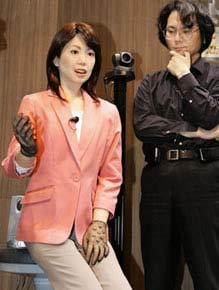New Robot Looks Strikingly Human

The ultra-lifelike robot Repliee Q1 made quite an impression at the 2005 World Expo in Japan. Shown below (at left!) with co-creator Hiroshi Ishiguru, the robot is so lifelike that roboticists may want to start working on a Bladerunner-style Voight-Kampff test now.

(From Ultra-Lifelike Robot Debuts in Japan)
Repliee Q1 has silicone for skin, rather than hard plastic. It has a number of sensors to allow it to react in a manner that appears natural; it appears to flutter its eyelids, chest movements correspond to breathing, and other tiny shifts in position that mimic unconscious human movement.The android can mimic actions made by a human; this helps the robot's movements appear more lifelike. By facing a person with reflective dots placed at key points (like wrist, elbow, palm), the robot can try to match those points on its own body with those of the person who is "modeling" human movement.
The greatest limit to the lifelike movement of the robot is that it has only 31 actuators in its upper body; a nearby air compressor provides the energy needed for articulation.
In his excellent novel Do Androids Dream of Electric Sheep, Philip K. Dick explores what happens in a society when android replica humans cannot be physically distinguished from human beings. Only the Voight-Kampff empathy test can make the distinction, when used by a trained officer like Rick Deckard:
"I'm not a peace officer," Rick said. "I'm a bounty hunter." From his opened briefcase he fished out the Voight-Kampff apparatus, seated himself at a nearby rosewood coffee table, and began to assemble the rather simple polygraphic instruments... (Read more about the Voight-Kampff test)
San Francisco's Wave magazine recently wondered whether or not candidates for their mayoral elections were humans or androids; they applied an empathy test to make sure. See Is Your Candidate Human?. Read more about Repliee Q1 in Ultra-Lifelike Robot; more materials available at Android Science. Thanks to Andy Gowland for contributing the tip on this story.
(This Science Fiction in the News story used with permission from Technovelgy.com - where science meets fiction.)
Sign up for the Live Science daily newsletter now
Get the world’s most fascinating discoveries delivered straight to your inbox.









